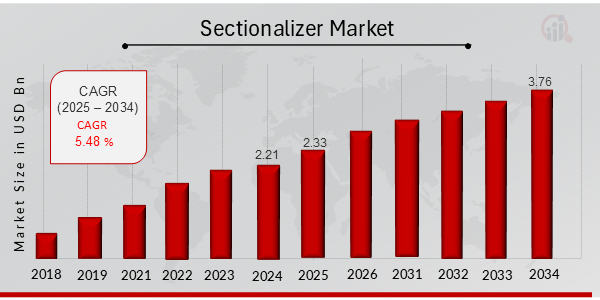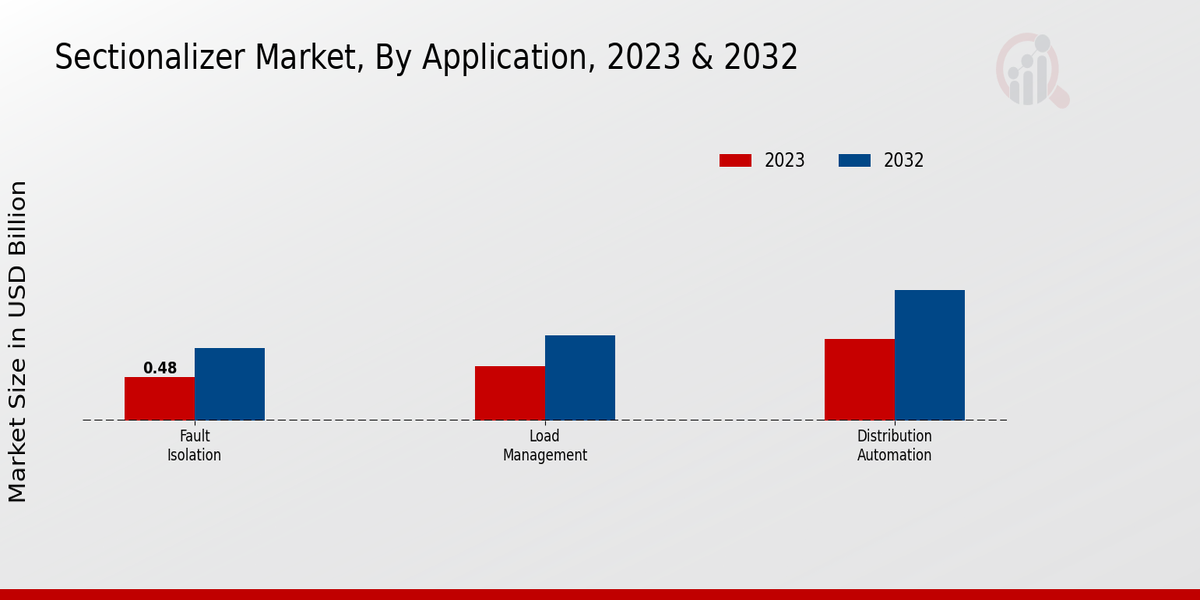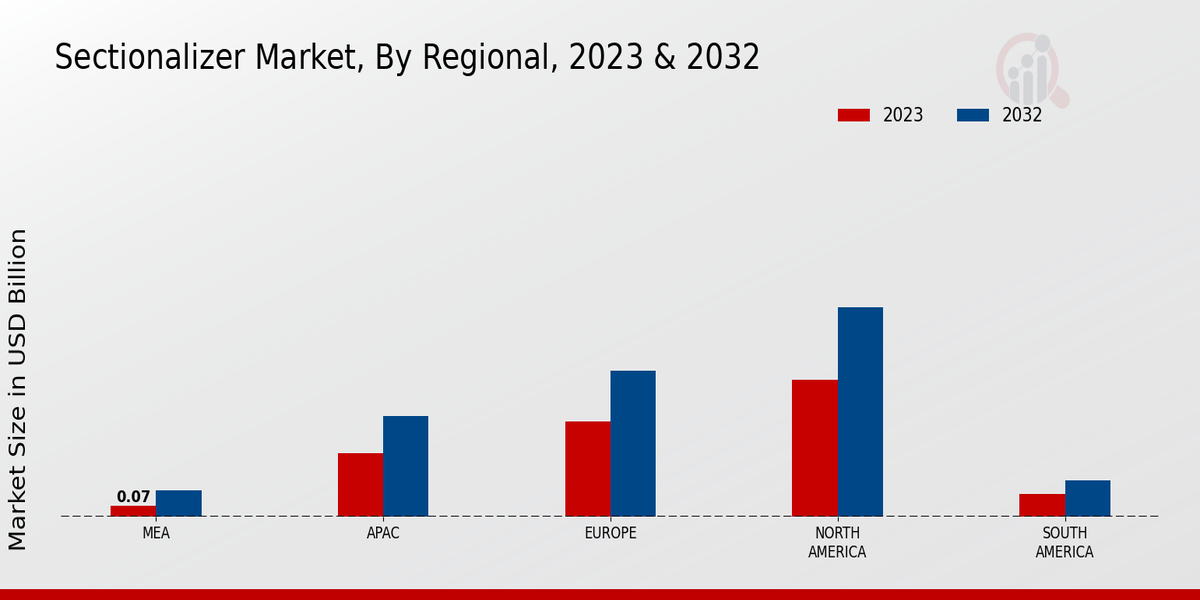Global Sectionalizer Market Overview
As per MRFR analysis, the Sectionalizer Market Size was estimated at 2.21 (USD Billion) in 2024. The Sectionalizer Market Industry is expected to grow from 2.33 (USD Billion) in 2025 to 3.76 (USD Billion) till 2034, at a CAGR (growth rate) is expected to be around 5.48% during the forecast period (2025 - 2034)
Key Sectionalizer Market Trends Highlighted
The Sectionalizer Market is witnessing significant growth driven by the increasing demand for reliable electrical distribution systems. Factors such as the need for improved energy efficiency, the rise in renewable energy sources, and aging infrastructure are propelling the adoption of sectionalizers. These devices enhance the reliability of electrical networks, allowing for quick isolation of faults and minimizing downtime. Additionally, the push for smart grid technologies is further boosting market interest, as sectionalizers play a crucial role in advanced distribution automation systems. There are numerous opportunities in the market to explore and capture, particularly in emerging economies where infrastructure development is rapidly advancing.
The growing emphasis on sustainability and environmental protection will also drive investments in modernizing existing electrical grids. Manufacturers can explore collaborations and partnerships to integrate sectionalizers into automated systems, enhancing their functionality. Targeting utility companies and expanding product offerings for specific regional needs can further attract new customers. Recent trends indicate a shift towards smart sectionalizers equipped with remote monitoring and control capabilities. This development aligns with the broader movement towards digitalization in the energy sector. Companies are increasingly focused on innovation, leading to the introduction of more efficient and user-friendly models.
The integration of Internet of Things (IoT) technology in sectionalizers fosters better performance and data collection, enabling utilities to manage their networks more effectively. This combination of technological advancement with rising consumer expectations for reliable service is shaping the future of the Sectionalizer Market. As the industry evolves, adapting to these trends will be essential for staying competitive and meeting the demands of customers.

Source: Primary Research, Secondary Research, MRFR Database and Analyst Review
Sectionalizer Market Drivers
Growing Demand for Smart Grids and Energy Management Systems
The Sectionalizer Market Industry is experiencing significant growth driven by the increasing emphasis on smart grids and advanced energy management systems. As countries strive to modernize their power infrastructure, the integration of technological solutions to improve efficiency and reliability is becoming paramount. Smart grids are designed to facilitate enhanced monitoring and management of energy distribution, minimizing outages and ensuring a stable supply of electricity.
This rise in demand for smarter energy solutions enables utilities to deploy sectionalizers that automate the operation of electrical networks, leading to reduced downtime and improved customer satisfaction. Furthermore, the transition towards more sustainable energy sources intensifies the need for efficient power distribution mechanisms. Sectionalizers play a critical role in ensuring that renewable energy sources such as wind and solar can be effectively incorporated into the existing grid without compromising on reliability or safety.
As regulatory bodies and governments worldwide push for cleaner energy practices and infrastructure upgrades, the Sectionalizer Market Industry is likely to see consistent investment and innovation, driving expanded market growth and providing prospects for future advancements in the sector.
Rising Investments in Power Infrastructure
As economies recuperate from global recessions and focus on rebuilding, there has been a substantial increase in investments directed towards power infrastructure. The Sectionalizer Market Industry benefits from these capital expenditures aimed at enhancing grid reliability and expanding capacity. Governments and private sectors are recognizing that maintaining an efficient electricity supply is crucial for economic growth, prompting ongoing projects that require sectionalizing equipment. These investments are expected to continue as the demand for electricity grows, driven by electrification efforts across various sectors.
Increased Adoption of Distribution Automation
The shift towards distribution automation is another significant driver for the Sectionalizer Market Industry, as utilities aim to improve operational efficiency and reduce operational costs. By implementing automated systems, companies can respond more swiftly to outages and manage loads effectively, which leads to enhanced service delivery. The integration of sectionalizers into distribution networks allows for better segmentation of the power system, resulting in improved fault detection and localization capabilities. This growing trend towards automation is poised to propel the market, as utilities continually seek innovative solutions to meet consumer demands.
Sectionalizer Market Segment Insights
Sectionalizer Market Application Insights
The Sectionalizer Market is experiencing significant growth within its Application segment, which encompasses various critical functions aiming to enhance the efficiency of electrical distribution systems. In 2023, this segment is collectively valued at 1.98 USD Billion and is expected to grow further, reflecting the increasing emphasis on technological advancements in electricity management. Within this Application segment, Distribution Automation emerges as a dominant player, valued at 0.9 USD Billion in 2023, projected to escalate to 1.45 USD Billion by 2032.
This importance stems from the push toward smarter grids, which facilitate real-time monitoring and control of the power distribution network, thus optimizing energy delivery and minimizing outages. Load Management follows as another significant area, initially valued at 0.6 USD Billion in 2023 with a growth potential to reach 0.95 USD Billion in 2032. The imperative for efficient energy distribution reflects the need for effective load balancing and consumption management, essential for maintaining grid stability and economic energy use. Lastly, the Fault Isolation application, although smaller with a value of 0.48 USD Billion in 2023, is projected to rise to 0.8 USD Billion by 2032.
Its importance lies in promptly and accurately isolating faults in electrical networks, thereby safeguarding infrastructure, reducing downtime, and promoting safety. The combination of these applications within the Sectionalizer Market highlights the critical role they play in meeting the rising demands for reliable and efficient energy distribution, driven by urbanization, technological innovation, and the transition towards sustainable energy practices. The majority holding of the Distribution Automation segment underscores its significance in shaping the future of the energy landscape, as utilities and energy providers seek to streamline operations and enhance service reliability.
In conclusion, the Application segment within the Sectionalizer Market showcases a healthy growth trajectory, propelled by enhanced technological integrations and an overarching demand for improved energy management solutions across the globe.

Source: Primary Research, Secondary Research, MRFR Database and Analyst Review
Sectionalizer Market Type Insights
The Sectionalizer Market revenue reflects a significant trend in its Type segmentation, which comprises Electromechanical Sectionalizers, Electronic Sectionalizers, and Smart Sectionalizers. In 2023, the overall market was valued at 1.98 USD Billion, showcasing the growing demand for reliable distribution systems. The market is characterized by a shift towards Electronic and Smart Sectionalizers, driven by the need for enhanced automation and efficiency in electrical networks. Electronic Sectionalizers are increasingly favored for their precision, improving outage management and reducing downtime.
Meanwhile, Smart Sectionalizers are gaining traction due to their ability to integrate with advanced smart grid technologies, enabling real-time monitoring and control. The deployment of these modern devices highlights the industry's focus on improving grid resilience and reliability. This favorable market movement is supported by an increase in renewable energy sources and the need to maintain stable electricity supply, further propelling the market growth in the coming years and providing numerous opportunities for innovation. Overall, the Sectionalizer Market data indicates a robust future for these important types as they adapt to the evolving requirements of power distribution and management.
Sectionalizer Market End Use Insights
The Sectionalizer Market is expected to experience growth across various end-use categories, including Utilities, Commercial, and Industrial sectors. In 2023, the overall market was valued at 1.98 billion USD, reflecting the demand for efficient solutions in power distribution and management. The Utilities sector significantly dominates this market due to the increasing need for reliable electrical infrastructure and grid modernization, which drives the adoption of sectionalizers. Commercial applications are also critical, as businesses strive for energy efficiency and reduced operational costs, leveraging sectionalizers to ensure consistent power supply.
Meanwhile, the Industrial segment is gaining attention for its focus on automation and smart technologies, where sectionalizers play a pivotal role in enhancing system reliability and reducing downtime. Factors like technological advancements and regulatory initiatives supporting renewable energy sources contribute to the robust growth trajectory of the overall market. The Sectionalizer Market statistics indicate a dynamic landscape where each segment presents distinct opportunities for innovation and improvement in power distribution systems.
Sectionalizer Market Voltage Level Insights
The Sectionalizer Market, particularly around the Voltage Level segment, demonstrates considerable growth potential as it adapts to the demands of modern energy distribution. In 2023, this market segment was valued at 1.98 billion, reflecting the increasing need for efficient and reliable electrical grid systems worldwide. As utilities and industries focus on enhancing energy efficiency, the Low Voltage category has gained traction, being crucial for residential and commercial applications where safety and reliability are paramount. Medium Voltage systems also play a significant role, being pivotal in urban infrastructure and industrial setups, contributing to the overall efficiency of electricity distribution.
High Voltage technology commands a dominant position due to its capacity to transmit large amounts of power over long distances, vital for large-scale energy projects and interconnections. The overall Sectionalizer Market revenue is projected to expand further, with trends towards smart grid solutions and renewable energy integration driving growth, presenting opportunities for innovation and investment in the industry. However, challenges such as evolving regulatory standards and the need for skilled labor in maintaining these systems remain prevalent.
Sectionalizer Market Regional Insights
The Regional segment of the Sectionalizer Market reveals significant opportunities for growth and development, with the market valued at 1.98 USD Billion in 2023 and projected to reach 3.2 USD Billion by 2032. Within this segment, North America holds a majority with a valuation of 0.82 USD Billion in 2023, increasing to 1.25 USD Billion in 2032, making it a dominant player due to advanced infrastructure and technology adoption. Europe follows closely, valued at 0.57 USD Billion in 2023 and expected to grow to 0.87 USD Billion by 2032, demonstrating a significant demand for sectionalizers in its energy sector.
The APAC region, valued at 0.38 USD Billion in 2023 and forecasted to reach 0.6 USD Billion by 2032, is emerging as a key market driven by increased urbanization and investment in grid modernization. South America, with a valuation of 0.14 USD Billion in 2023, is expected to see modest growth to 0.22 USD Billion by 2032, highlighting its developing energy infrastructure. Meanwhile, the MEA region, valued at 0.07 USD Billion in 2023, shows potential for growth, with a projection of 0.16 USD Billion by 2032, as energy demands increase and modernization efforts continue. Overall, the Sectionalizer Market data indicates varied growth trajectories across these regions, driven by factors such as technological advancements, infrastructure development, and increasing energy demands.

Source: Primary Research, Secondary Research, MRFR Database and Analyst Review
Sectionalizer Market Key Players and Competitive Insights
The Sectionalizer Market has been witnessing significant growth and development due to the increasing need for reliable electrical distribution systems across various industries. As more industries and utility providers seek efficient and effective solutions to manage power flow and improve system reliability, the competition among manufacturers has intensified. This competitive landscape is characterized by a mix of established players and emerging companies, all striving to enhance their product offerings through innovation, technology advancements, and strategic partnerships. Market dynamics such as pricing strategies, product differentiation, and geographical expansion play crucial roles in shaping competitive positions and determining market share.
Understanding these competitive insights is essential for stakeholders looking to navigate the complexities of the market.ABB is a prominent player in the Sectionalizer Market, known for its robust technological solutions and extensive experience in the energy and automation sectors. The company has established a strong market presence due to its commitment to high-quality products that ensure operational efficiency and reliability. With a comprehensive portfolio that includes innovative sectionalizers designed to optimize power distribution networks, ABB effectively addresses the needs of utility providers and industrial customers alike. The company’s strengths lie in its strong research and development capabilities, enabling it to stay at the forefront of technological advancements and maintain a competitive edge. Furthermore, ABB’s global reach and well-established distribution channels provide it with significant market leverage, allowing it to deliver its solutions efficiently across different regions.
Klein Tools is another noteworthy contender in the Sectionalizer Market, recognized for its focus on high-performance tools and solutions tailored for electrical professionals. The company has garnered a reputation for quality and reliability, which is crucial for users who rely on precision instruments for their daily operational needs. Klein Tools invests significantly in product development and innovation, continuously improving its offerings in line with industry demands. The company’s strengths lie in its ability to produce sectionalizers that are not only durable but also user-friendly, ensuring that customers can work efficiently and safely. With a commitment to professional-grade tools, Klein Tools has successfully carved out a niche market by aligning its product features with the expectations of electrical contractors and utilities, making it a strong competitor in the sectionalizer segment.
Key Companies in the Sectionalizer Market Include
- ABB
- Klein Tools
- NHP Electrical Engineering Products
- SEL
- Hubbell
- Mitsubishi Electric
- S and C Electric Company
- General Electric
- Crompton Greaves
- Toshiba
- Siemens
- Eaton
- G and W Electric
- Rittal
- Schneider Electric
Sectionalizer Market Industry Developments
The Sectionalizer Market has seen significant developments recently, particularly influenced by key players such as ABB, Schneider Electric, Eaton, and Siemens, who are investing heavily in advancements to enhance their product offerings. The trend towards automation and smart grid technology is pushing these companies to innovate, with significant R&D efforts expected to speed up market growth. Current affairs include the increased demand for sectionalizers driven by the need for improved power reliability and efficiency across various industries.
Additionally, mergers and acquisitions have been prominent, with notable developments involving companies like General Electric and Toshiba, where strategic partnerships aim to bolster their market positioning and expand product lines in response to rising consumer demands. This competitive landscape is complemented by the influx of new players aiming to capture market share, driven by increasing investments in renewable energy and infrastructure improvements. Overall, the valuation of these companies is witnessing growth, bolstered by emerging trends and technological advancements that are shaping the future of the Sectionalizer Market.
Sectionalizer Market Segmentation Insights
- Sectionalizer Market Application Outlook
- Distribution Automation
- Load Management
- Fault Isolation
- Sectionalizer Market Type Outlook
- Electromechanical Sectionalizers
- Electronic Sectionalizers
- Smart Sectionalizers
- Sectionalizer Market End Use Outlook
- Utilities
- Commercial
- Industrial
- Sectionalizer Market Voltage Level Outlook
- Low Voltage
- Medium Voltage
- High Voltage
| Report Attribute/Metric |
Details |
|
Market Size 2024
|
2.21 (USD Billion)
|
|
Market Size 2025
|
2.33 (USD Billion)
|
|
Market Size 2034
|
3.76 (USD Billion)
|
|
Compound Annual Growth Rate (CAGR)
|
5.48% (2025 - 2034)
|
|
Report Coverage
|
Revenue Forecast, Competitive Landscape, Growth Factors, and Trends
|
|
Base Year
|
2024
|
|
Market Forecast Period
|
2025 - 2034
|
|
Historical Data
|
2019 - 2023
|
| Market Forecast Units |
USD Billion |
| Key Companies Profiled |
ABB, Klein Tools, NHP Electrical Engineering Products, SEL, Hubbell, Mitsubishi Electric, S and C Electric Company, General Electric, Crompton Greaves, Toshiba, Siemens, Eaton, G and W Electric, Rittal, Schneider Electric |
| Segments Covered |
Application, Type, End Use, Voltage Level, Regional |
| Key Market Opportunities |
Smart grid integration technology, Rising renewable energy adoption, Infrastructure upgrade initiatives, Demand for reliability and efficiency, Expansion in developing markets |
| Key Market Dynamics |
Technological advancements, Rising demand for renewable energy, Increased infrastructure investments, Stringent safety regulations, Expanding urbanization trends |
| Countries Covered |
North America, Europe, APAC, South America, MEA |
Frequently Asked Questions (FAQ) :
The Sectionalizer Market is projected to reach a value of 3.76 billion USD by 2034.
The expected CAGR for the Sectionalizer Market from 2025 to 2034 is 5.48%.
North America is expected to dominate the Sectionalizer Market with a value of 1.25 billion USD by 2032.
The market size for the Distribution Automation application is expected to reach 1.45 billion USD in 2032.
Key players in the Sectionalizer Market include ABB, Siemens, Schneider Electric, Mitsubishi Electric, and General Electric.
The anticipated market value for the Fault Isolation application is 0.8 billion USD by 2032.
The Load Management application is expected to grow to a market value of 0.95 billion USD by 2032.
The Sectionalizer Market is expected to be valued at 1.98 billion USD in 2023.
The APAC region is expected to grow to a market value of 0.6 billion USD by 2032.
The market value of the South America region is projected to be 0.22 billion USD by 2032.

















